The Huawei P8 Lite Review
by Brandon Chester on July 27, 2015 8:00 AM EST- Posted in
- Smartphones
- Huawei
- Mobile
Battery Life
A phone is only good to the user when it's charged, so having sufficient battery life to last throughout the day is of the utmost importance. Due to various factors of both hardware and software, it's impossible to determine how long a device will last based solely on the battery capacity. Even still, a device's battery capacity can provide some degree of insight into how long a device should last when also considering the hardware it has to power. In the case of the P8 Lite, the hardware runs off of an 8.36Wh battery, which is actually smaller than a phone like the 2015 Moto E with a smaller display. This is due to the more limited space afforded by the P8 Lite's 7.7mm thick chassis.
In order to characterize the P8 Lite's battery life in various scenarios I've run it through our standard battery tests. First up is the WiFi web browsing test to test battery life in a more display bound workflow, followed by BaseMark OS II, GFXBench 3.0 to test a GPU heavy workflow, and ending with PCMark which is a fairly balanced test of all components.
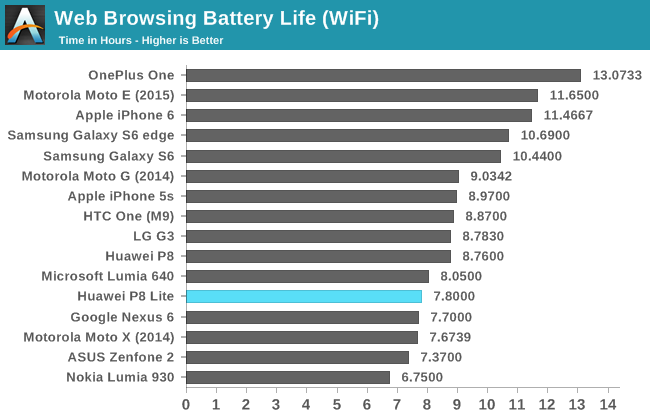
In our WiFi web browsing test the P8 Lite falls somewhat short of the median. It's surrounded by the Lumia 640 and the Google Nexus 6, with the ASUS Zenfone 2 sitting further below it but not by that much. In my view OEMs should really be targeting somewhere around 9 to 10 hours of battery life for web browsing at 200 nits, and at 7.8 hours the P8 Lite doesn't make that mark. What concerns me is that the Zenfone 2 isn't that far behind, and it's both $50 cheaper, significantly faster, and has a much sharper display. Better web browsing battery life definitely would have given the P8 Lite a much needed advantage over the competition.
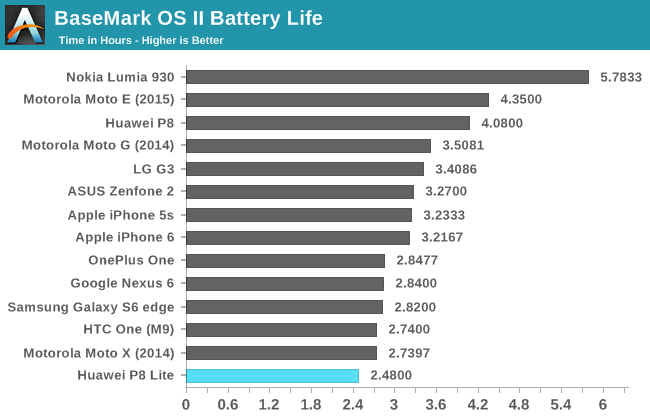
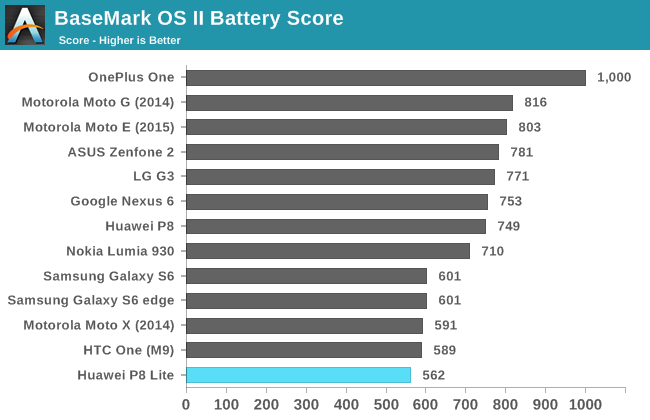
In BaseMark OS II's battery test the P8 Lite does not perform well at all. Not only is the battery life the shortest device on the chart, but sustained performance throughout the test is much lower than many other devices which leads to it also receiving the lowest battery score of our listed devices.
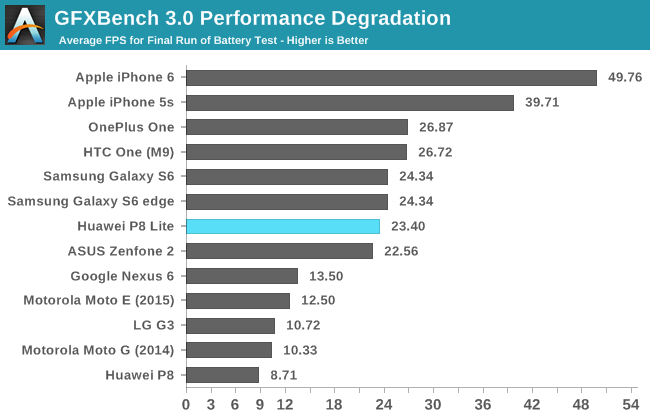
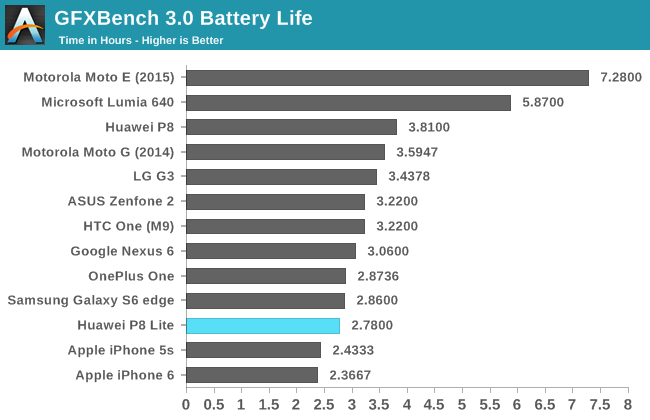
With its smaller battery and much higher sustained performance than devices like the Moto G, Moto E, and Lumia 640, it's not a surprise that the P8 Lite lasts a significantly shorter time in the GFXBench battery life test. However, the result doesn't sit far behind many other devices on the chart, and the P8 Lite achieves similar performance at its native resolution. What I can say about battery life in GPU intensive scenarios on the P8 Lite is that it's decent, and it's not at all unexpected given the device's hardware and battery capacity.
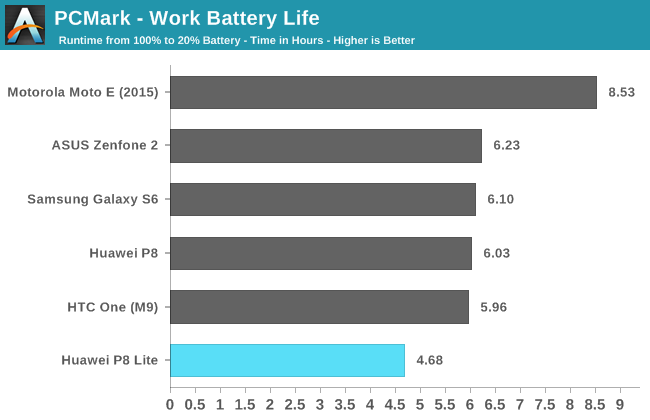
The P8 Lite demonstrates disappointing battery life in PCMark's battery benchmark. This benchmark consists of running through all of PCMark's standard tests in a loop, which gives a good idea of what battery life will be when the phone is subject to various different use cases over a period of time. At 4.68 hours, the P8 Lite falls well behind our other smartphones, and considerably far behind the 2015 Moto E which is a less expensive device.
It's clear from our battery tests that the battery life of the P8 Lite is quite short. This was fairly evident when using the device throughout the day. Something that isn't explicitly shown here is that there appears to be a large amount of battery drain when the device is idle. I often found the battery in need of a charge even during times when the device had only been laying on my desk for the night after minimal use during the day. As far as both active and idle battery life is concerned, the P8 Lite is disappointing.
Charge Time
Charge time isn't often thought of when considering what device to buy, but it can have a substantial impact on the user experience. If a phone lasts a short time and takes a long time to charge then a user can be without a usable device for a much longer period than the battery life alone would imply. On the flip side, a short charge time can improve the experience on a device with shorter than desired battery life by making it quick to get it back to a usable state.

The P8 Lite ships with a 5W charger in the box. Unfortunately, with its stock charger the P8 Lite has the longest charge time of all recent devices. This is a problem when coupled with the P8 Lite's short battery life, as it means the device will run out of power quickly and then take a long time to get back to a 100% charge again.


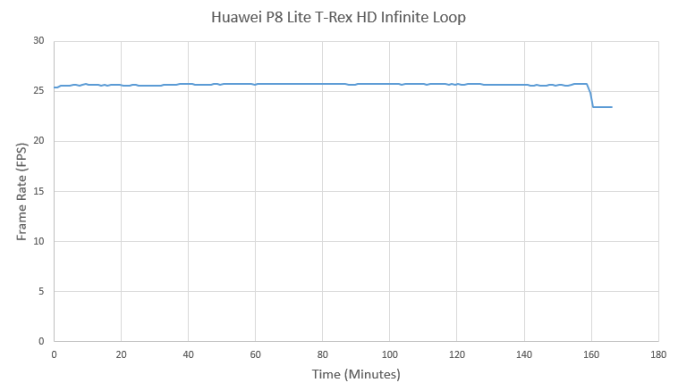








45 Comments
View All Comments
joeroyhud - Monday, July 27, 2015 - link
The P8 Lite supports LTE band 12, which makes it attractive if you're a T-Mobile customer like I am. I got the phone on sale a couple months ago for $200. I like the size and the performance and the battery life, but it's overpriced at $250.Glock24 - Monday, July 27, 2015 - link
This phone seems like a bad choice. Glad I got a ZenFone 2, but sure since I got the 4GB RAM/64GB flash version it cost me $300. Battery life on ZF2 is not great, but has improved a bit with system updates. I guess if the P8 Lite had Android 5.0 it would have even worse battery life.austinsguitar - Monday, July 27, 2015 - link
g4 pleaseedwd2 - Monday, July 27, 2015 - link
SD615 is a plain no for me. It's arguably worse than the SD600 and the MT6752 smokes it in every aspect at a lower price point.Speedfriend - Tuesday, July 28, 2015 - link
"As for performance, Snapdragon 615 is really the best you're going to get at this price point unless you go with the Zenfone 2 which is something of an anomaly in many ways. "Which begs the question why more manufacturers aren't using Intel chips which clearly smash the performance of any other mid range priced offerings?
Stick an Intel chip in a Moto G and I'll buy that!
LiverpoolFC5903 - Tuesday, July 28, 2015 - link
Agree, I dont understand why more manufacturers do not use the newer Silvermont based Intel chips, considering the performance levels and the low price. Much better than using mediocre socs like Snapdragon 410/615 at similar price points. Having used the ZF2, I can personally attest to its performance in handling anything Android has to offer.Buk Lau - Wednesday, July 29, 2015 - link
The answer is simple, Intel chips don't come with integrated modems. just look at zenfone 2, that thing comes with XMM 7262 with CAT 6 LTE disabled, and if this doesn't show you the problem already, Qualcomm's Gobi modem even comes with integrated GPS solution whereas Asus has to include a Broadcom solution. so just by using these atoms you already have to include 2 other chips whereas Qualcomm just gives you an all-in-one solution. then the choice is obvious, unless intel is literally paying money to you, which they did, what incentive is there for you to use their more complicated solution instead of qualcomm's? and this is how qualcomm got to become what it is today. back in the old days qualcomm's SoCs suffered even worse overheating and performance and yet OEMs still persist to use their stuff, simply because they offered an integrated modem. in a sense, OEMs only have themselves to blame rather than qualcomm for having to release junk phones all over this year, if they didn't spoil qualcomm so much back then, there wouldn't be so little choices in the SoC marketBadelhas - Tuesday, July 28, 2015 - link
The European / Asian version has Lollipop UI Emotion 3.1 and the their own HiSilicon's Kirin 620 SoC. Is it possible to review that one? Seems much better than the American version...A friend of mine bought one and it´s pretty slick, even if I continue to prefer the Moto E, considering the price.
PrinceGaz - Tuesday, July 28, 2015 - link
eww, you've got really hairy arms! (just joking, there were complaints in the comments about the iWatch that the guy wearing it had hairless arms :)So why would I want a phone with eight A53 CPUs? In my experience with a quad-core tablet, it rarely uses more than two of them fully when it is running at full speed, with the third and fourth cores doing a bit of work but hardly ever even approaching fully utilised (probably just running the tasks that need to be run anyway, so their main purpose is taking a tiny bit of work off the other cores).
Given that a 64-bit CPU is a bit unnecessary when phones have yet to reach 4GB RAM, and probably counter-productive power-wise as a result (just look at A15/A7 vs A57/A53), whilst benchmarks may run faster on a quad-core 1.5GHz A53, I suspect I'm better off with my old dual-core 1.7GHz Krait for most daily usage. It lasts me all day and never feels slow, and most of the time (according to a CPU usage monitor) one of the cores isn't being used much. I don't play 3D games much on my phone; so I never tax the GPU, therefore the Adreno 305 is perfectly fine for me,
What workload other than benchmarks requires more than two CPU cores? The main one that occurs to me is a browser, in which case you would be much better off culling battery draining processes rather than running them.
Ethos Evoss - Saturday, August 1, 2015 - link
pls honor 7 reviewthnx